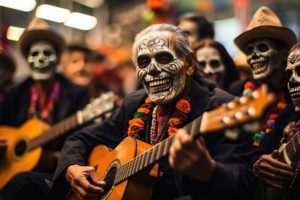Ever since the fall of the infamous ‘Iron Curtain’, the Czech Republic, and in particular its capital, Prague, has become an ever more popular tourist destination for millions annually. As if its rich history, fascinating culture, and spectacular local cuisine weren’t enough of a lure, the Czech Republic also boasts some of the most captivating architecture in Europe (I have heard it said on good authority that, in terms of sheer richness and visual delight, most TV shows can’t even begin to compete with the interior of St Nicholas’ Church.)
Prague is probably the quintessential location for those wanting to get their first taste of what the country has to offer. However, if you thought the key to snapping that share-worthy photo lay in sticking to the city center, you’d be very wrong indeed. Take a drive for one hour due east and you’ll arrive at the Central Bohemian city of Kutná Hora. Once there, have a look around for Sedlec Abbey – it won’t be difficult to find; the Abbey (now a UNESCO World Heritage Site) is a large 12th Century construction that was later remodeled in the Gothic style. Made from bleached stone and finished with orange tiles, Sedlec Abbey has the perfectly welcoming and pleasing exterior you’d expect from a church. But, should you head downstairs to the basement, prepare yourself for something more gothic than Lord Byron drinking wine from a hollowed-out skull: the Sedlec Ossuary.
Conservatively estimated to contain the skeletons of between 40,000 to 70,000 people, the ossuary is both macabre and ingeniously creative in equal measure. Featuring a multitude of skeletal arrangements and accoutrements, including an altar, wall displays, chalices, and commemorative writing all made with bones, the Ossuary also boasts a huge skeleton chandelier as its grim centerpiece (apparently constructed from every single bone in the human body). It really must be seen to be believed; it goes so contrary to what one would expect from church décor, you could be forgiven for thinking you’d stumbled upon the set of a horror movie!
So how did this haunting marvel in the basement come to be? History tells us that during the 13th Century, an abbot from the local clergy made a pilgrimage to the Holy Land and brought some sacred earth back from his travels. Having consecrated Sedloc Abbey’s grounds with said dirt, news began to spread among the denizens of Kutná Hora and soon people were literally dying to be buried there. Later, in the wake of the Black Death and the perpetual state of war that existed in Europe at that time, there was more death than the grounds of Sedloc Abbey could possibly house comfortably. It wasn’t until the 19th Century that a woodcarver named Frantisek Rint was tasked with organizing the colossal quantity of bones that had accumulated.
The patrons for Rint’s work were the Schwarzenberg’s – a Czech-German aristocratic family whose coat of arms (made of – you guessed it – bones!) hangs proudly in the ossuary. An enormous assortment of femurs, fingers, vertebrae, pelvises, and shoulder-blades create the effect, which includes a crown motif at the top and a raven pecking at a skull. The art that Rint has left behind is a highly affecting statement for the observer and has served as inspiration for a whole host of media: many authors and filmmakers have been particularly struck by the stark comment the ossuary makes about life and death.
In the Medieval Christian theological tradition was the concept of memento mori – the regular and serious contemplation of one’s mortality (the Latin literally translates as ‘remember that you have to die’). The aim of this was to focus the meditator’s attention on the more substantial/important things in their life, rather than the transient worries we all fret about daily. If the Sedlec Ossuary achieves anything, it is to remind the observer that they too, one day, will become like the legions of bones decorating the room. However, the sheer creativity of the artist’s work can’t help but imbue the ossuary with a darkly mischievous sense of fun – even humor! It’s a fact that we all must die one day, but that’s not to say we can’t utilize every opportunity to enjoy life whilst we’re still here.







